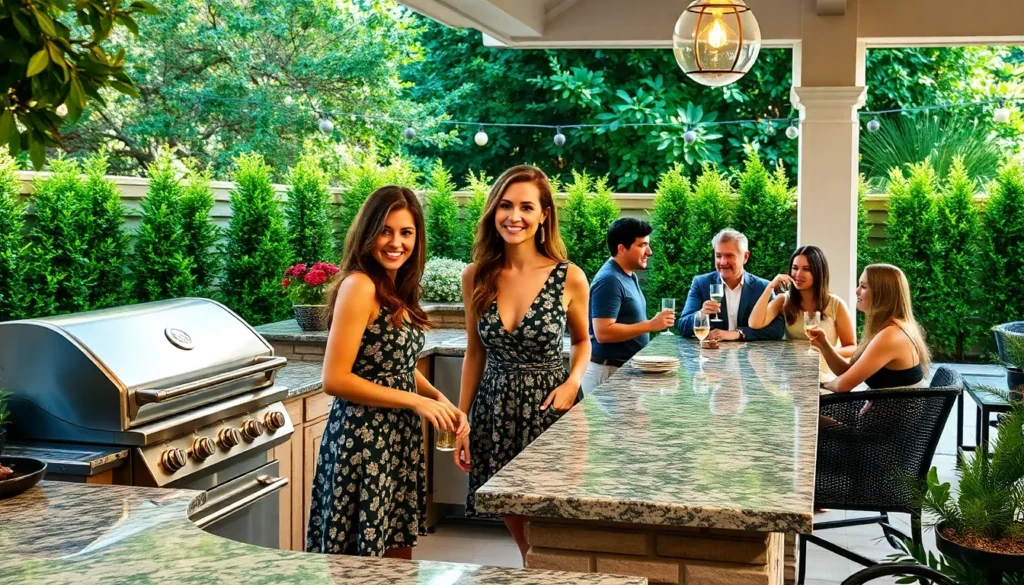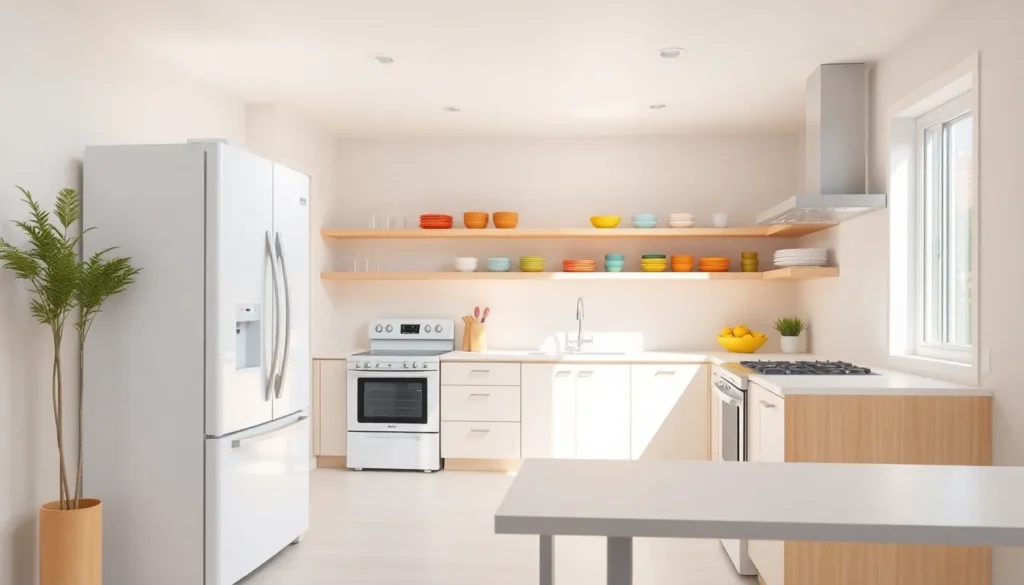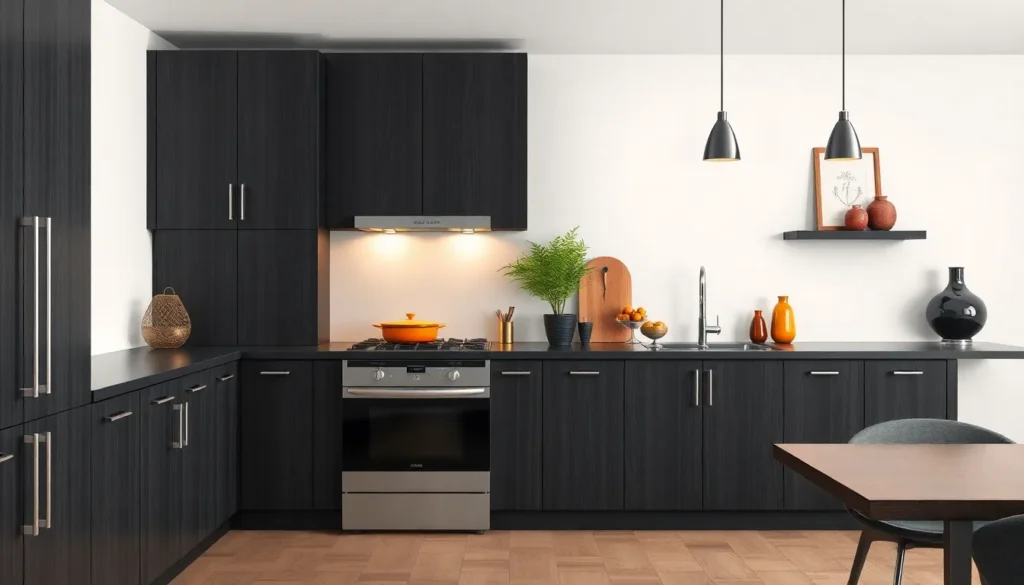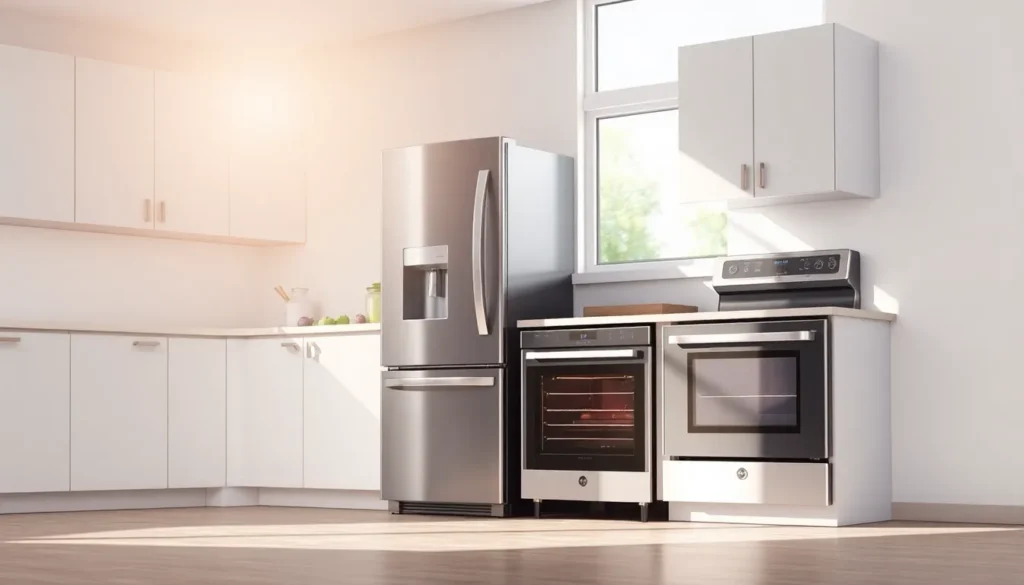Transitional kitchens are the stylish chameleons of home design. They effortlessly blend traditional charm with modern flair, creating spaces that feel both timeless and fresh. Imagine whipping up a gourmet meal while surrounded by sleek lines, warm woods, and just the right amount of whimsy. It’s like having a dinner party where your guests can’t decide if they’re in a cozy cottage or a trendy urban loft.
Table of Contents
ToggleWhat Are Transitional Kitchens?
Transitional kitchens blend traditional and modern design elements seamlessly. These spaces feature clean lines, a neutral color palette, and refined finishes that create a serene and inviting atmosphere. Characterized by a mix of textures, transitional kitchens use materials like wood, metal, and stone, fostering warmth while adding an updated look.
Cabinets often showcase Shaker styles alongside sleek, high-gloss finishes, providing visual interest. Countertops in quartz or granite contribute to functionality and elegance. Lighting fixtures, such as minimalist pendant lights, enhance the overall aesthetic and serve practical purposes.
Layouts for transitional kitchens prioritize open-concept designs. These layouts encourage interaction and fluid movement between spaces, making them ideal for entertaining. Additionally, thoughtful storage solutions, like built-in shelves and hidden compartments, maintain organization without sacrificing style.
Furniture selections in transitional kitchens reflect versatility. Chairs and stools often feature comfortable upholstery alongside sophisticated lines. Accessories, including decorative vases and stylish kitchenware, add personal touches that further enhance the ambiance.
Color schemes in these kitchens typically revolve around earth tones, accented by pops of color through accessories or artwork. The result is a balance between warmth and sophistication, appealing to various tastes. As a result, transitional kitchens offer a timeless yet contemporary vibe, suitable for both everyday family use and upscale gatherings.
Key Features of Transitional Kitchens

Transitional kitchens merge traditional charm with contemporary elegance. Key aspects include a careful selection of colors, cabinet styles, and materials that emphasize the unique blend of these design philosophies.
Color Palette
Color schemes in transitional kitchens focus on neutral bases with an emphasis on whites and grays. The use of earth tones adds warmth, creating a cozy atmosphere. Accents often include deeper shades and vibrant hues, introduced through accessories or artwork. This strategic approach yields a balanced and inviting environment, perfect for any occasion. Mixing different tones allows for personal expression while maintaining harmony throughout the space.
Cabinet Styles
Cabinet styles in transitional kitchens showcase a blend of tradition and modernity. Shaker-style cabinets are frequently used for their timeless appeal. Alternatively, high-gloss finishes provide a sleek, contemporary look. Combining these styles maintains visual interest while promoting functionality. Glass-front cabinets often display curated dishware, enhancing the kitchen’s aesthetic. Thoughtful hardware choices can further unify the design, emphasizing the seamless flow between traditional elements and modern touches.
Countertops and Backsplashes
Countertops in transitional kitchens prioritize durability and elegance. Materials like quartz and granite are popular due to their robustness and variety of patterns. These surfaces create a polished look that complements the overall design. Backsplashes often feature subway tiles or textured materials, enhancing depth and dimension. The selection of contrasting or coordinating colors between countertops and backsplashes supports the kitchen’s cohesive appearance. These design choices serve both form and function, effectively balancing practicality with style.
Benefits of Transitional Kitchens
Transitional kitchens provide a blend of style and functionality, making them an excellent choice for various lifestyles.
Versatility and Flexibility
Transitional kitchens adapt to diverse design preferences, easily accommodating changes in decor and lifestyle. Those spaces often merge traditional charm with modern efficiency, creating an environment that suits casual family meals or entertaining guests. Customizable features enhance usability, allowing homeowners to modify layouts and storage solutions based on their needs. Adjustable lighting options cater to different activities, from cooking to dining. A mix of textures, materials, and colors fosters an inviting atmosphere that can evolve over time, showcasing personal styles without feeling dated.
Timeless Aesthetic
Timeless aesthetics define transitional kitchens, making them appealing across generations. A neutral color palette serves as a canvas for warmth and sophistication, with whites, grays, and earth tones creating a serene environment. Classic cabinetry styles, such as Shaker, offer a sense of tradition while sleek finishes introduce a modern edge. Durable materials, including granite and quartz, not only enhance visual appeal but also ensure longevity. Accessories and artwork add unique character, allowing for personalization while maintaining a cohesive look. This balance fosters a space that remains stylish and relevant, even as trends shift.
Designing Your Transitional Kitchen
Designing a transitional kitchen involves thoughtful considerations regarding layout and material choices. The goal centers around blending traditional and modern elements seamlessly.
Layout Considerations
Open-concept layouts stand out as essential in transitional kitchens. They facilitate interaction among family members and guests, creating an inviting atmosphere. Incorporating an island or a large peninsula can enhance workspace while encouraging social gatherings. Thoughtful placement of appliances minimizes unnecessary movement, ensuring efficiency in cooking and serving areas. Integrating built-in storage solutions also maintains organization, allowing for clean lines and a clutter-free environment. Attention to sightlines ensures that the overall aesthetic remains cohesive while prioritizing functionality.
Choosing the Right Materials
Selecting materials plays a crucial role in achieving the desired transitional look. Quartz and granite countertops provide durability and elegance, making them ideal for busy kitchens. Conversely, cabinetry featuring wood or high-gloss finishes adds texture while reflecting personal style. Mixing metals, such as brushed nickel and chrome, creates visual interest without overwhelming the space. Incorporating a variety of textures, like smooth surfaces combined with natural wood grains, enhances warmth and sophistication. Choosing neutral colors for larger elements while using brighter accents in decor allows for personal expression without sacrificing a harmonious design.
Transitional kitchens stand out for their ability to marry traditional and contemporary styles effortlessly. This design approach not only fosters a warm and inviting atmosphere but also ensures practicality for everyday life and entertaining.
With their focus on clean lines and versatile materials, these kitchens adapt to changing trends and personal tastes. Homeowners can enjoy a space that remains stylish and functional, making it a timeless choice for any home.
Ultimately, the transitional kitchen embodies a perfect balance of elegance and comfort, creating an environment that resonates with both family and guests alike.









